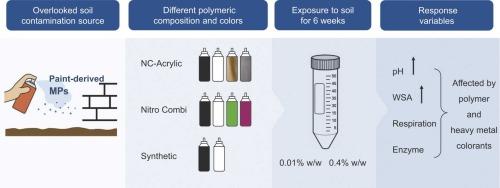喷漆衍生的微塑料通过其复合成分影响土壤特性和微生物活性
IF 11.3
1区 环境科学与生态学
Q1 ENGINEERING, ENVIRONMENTAL
引用次数: 0
摘要
油漆衍生的微塑料(MPs)越来越被认为是一个被忽视但潜在的重要陆地污染源。为了研究它们对土壤健康的生态影响,我们使用10种不同聚合物成分和颜色的市售喷漆进行了为期6周的对照土壤培养实验。以环境相关浓度(0.01%和0.4% w/w)应用油漆衍生MPs。测定了土壤pH、水稳团聚体、土壤呼吸和与碳、氮、磷循环相关的酶活性。结果表明,涂料类多磺酸粘多糖在高浓度下提高了土壤pH值,增强了水稳性团聚体的稳定性。具有不同聚合成分的涂料在使用时产生具有不同尺寸分布的MPs;这些来自油漆的MPs调节了土壤呼吸动力学。颜色对颜料衍生MPs毒性的影响似乎主要与金属颜料有关。特别是,含有铜的油漆衍生MPs对所有测量参数均显示出显着的负面影响。此外,油漆衍生的MPs表现出与浓度相关的毒性模式,这可能归因于其配方中嵌入的各种添加剂。该研究为油漆衍生MPs的环境风险提供了新的见解,并强调了其复合成分在确定其对土壤生态系统的生态影响中的作用。这些发现强调了提高涂料配方透明度和对有害成分进行更严格监管的重要性。本文章由计算机程序翻译,如有差异,请以英文原文为准。

Spray paint-derived microplastics influence soil properties and microbial activity through their composite composition
Paint-derived microplastics (MPs) are increasingly recognized as an overlooked but potentially significant source of terrestrial pollution. To investigate their ecological effects on soil health, we conducted a controlled six-week soil incubation experiment using 10 commercially available spray paints with varying polymer compositions and colors. Paint-derived MPs were applied at environmentally relevant concentrations (0.01% and 0.4% w/w). Soil pH, water-stable aggregates, soil respiration, and enzyme activities related to carbon, nitrogen, and phosphorus cycling were measured. Results showed that paint-derived MPs increased soil pH at the high concentration and reinforced the stability of water-stable aggregates. Paints with distinct polymeric compositions generated MPs with different size distributions upon application; these paint-derived MPs modulated soil respiration dynamics. The influence of color on the toxicity of paint-derived MPs appears to be primarily associated with metal pigments. In particular, paint-derived MPs containing copper consistently showed significant negative effects on all measured parameters. Furthermore, paint-derived MPs exhibited concentration-related toxicity patterns, which may be attributed to the various additives embedded in their formulations. This study provides new insights into the environmental risks of paint-derived MPs and highlights the role of their composite composition in determining their ecological impact on soil ecosystems. These findings underscore the importance of greater transparency in paint formulations and stricter regulation of hazardous components.
求助全文
通过发布文献求助,成功后即可免费获取论文全文。
去求助
来源期刊

Journal of Hazardous Materials
工程技术-工程:环境
CiteScore
25.40
自引率
5.90%
发文量
3059
审稿时长
58 days
期刊介绍:
The Journal of Hazardous Materials serves as a global platform for promoting cutting-edge research in the field of Environmental Science and Engineering. Our publication features a wide range of articles, including full-length research papers, review articles, and perspectives, with the aim of enhancing our understanding of the dangers and risks associated with various materials concerning public health and the environment. It is important to note that the term "environmental contaminants" refers specifically to substances that pose hazardous effects through contamination, while excluding those that do not have such impacts on the environment or human health. Moreover, we emphasize the distinction between wastes and hazardous materials in order to provide further clarity on the scope of the journal. We have a keen interest in exploring specific compounds and microbial agents that have adverse effects on the environment.
 求助内容:
求助内容: 应助结果提醒方式:
应助结果提醒方式:


